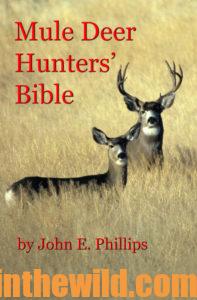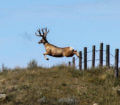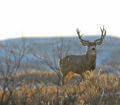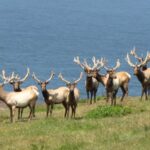 Editor’s Note: Longtime, avid hunter Marshall Johnson of Bismarck, North Dakota, is the senior regional director for the Mule Deer Foundation https://muledeer.org/ that restores, improves and protects mule deer habitat, including land and easement acquisitions, and develops programs that help mule deer and black-tailed deer conservation. Mule deer and black-tailed deer live throughout western North America from the coastal islands of Alaska down the West Coast to southern Baja, Mexico, and from the northern border of the Mexican state of Zacatecas, up through the Great Plains to the Canadian provinces of Saskatchewan, Alberta, British Columbia and the southern Yukon Territory. Mule deer: are browsers with a majority of their diet weeds and leaves and twigs of woody shrubs; grow 3 to 3-1/2 feet tall and generally weigh 130-280 pounds; have a 310-degree view around themselves due to their eyes being located on the sides of their heads; can detect movement up to 1900+ feet away; and have a sense of smell 1,000 times stronger than a human’s.
Editor’s Note: Longtime, avid hunter Marshall Johnson of Bismarck, North Dakota, is the senior regional director for the Mule Deer Foundation https://muledeer.org/ that restores, improves and protects mule deer habitat, including land and easement acquisitions, and develops programs that help mule deer and black-tailed deer conservation. Mule deer and black-tailed deer live throughout western North America from the coastal islands of Alaska down the West Coast to southern Baja, Mexico, and from the northern border of the Mexican state of Zacatecas, up through the Great Plains to the Canadian provinces of Saskatchewan, Alberta, British Columbia and the southern Yukon Territory. Mule deer: are browsers with a majority of their diet weeds and leaves and twigs of woody shrubs; grow 3 to 3-1/2 feet tall and generally weigh 130-280 pounds; have a 310-degree view around themselves due to their eyes being located on the sides of their heads; can detect movement up to 1900+ feet away; and have a sense of smell 1,000 times stronger than a human’s.
When you take a look nationally at all the predators that feed on mule deer, the mountain lion and the coyote are the two predators that seem to be taking the most mule deer, more so than the wolves. The wolves’ primary diet seems to be elk. Yes, wolves do take mule deer, but they seem to prefer elk. And, yes, there are certain pockets like those in the Bitterroot Mountains https://www.fs.usda.gov/bitterroot up near the Canadian border where you’ll see that wolves have impacted the mule deer there. However, those wolves in that area have been there for quite some time.

In western North Dakota, Montana, Wyoming, Colorado and Idaho, there are certain places where the populations of mountain lions are fairly high. Mountain lions will do some damage to a mule-deer herd. The coyotes seem to affect the mule-deer herd primarily during the fawning season in May and June. However, if our section of the U.S. has winters with heavy snows, all predators will catch and eat mule deer, due to the mule deer not being able to escape as easily as when there’s not that much snow on the ground. That’s when we start seeing photos being sent in of three or four coyotes that have pushed a mule deer out on the ice and attacked it. Or, the mule deer may be stuck in a ditch during periods of heavy snow.

 To learn more about hunting mule deer, go to John E. Phillips’ book, “Mule Deer Hunters’ Bible,” available in Kindle and print versions and including information from 30+ mule deer hunters, at https://www.amazon.com/dp/B07QHCLFYB.
To learn more about hunting mule deer, go to John E. Phillips’ book, “Mule Deer Hunters’ Bible,” available in Kindle and print versions and including information from 30+ mule deer hunters, at https://www.amazon.com/dp/B07QHCLFYB.










